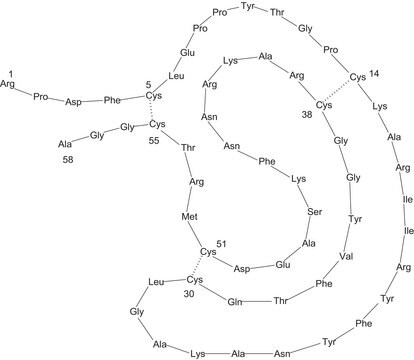If this product has an expiration or retest date, it will be shown on the Certificate of Analysis (COA, CofA). If there is no retest or expiration date listed on the product's COA, we do not have suitable stability data to determine a shelf life. For these products, the only date on the COA will be the release date; a retest, expiration, or use-by-date will not be displayed.
For all products, we recommend handling per defined conditions as printed in our product literature and website product descriptions. We recommend that products should be routinely inspected by customers to ensure they perform as expected.
For products without retest or expiration dates, our standard warranty of 1 year from the date of shipment is applicable.
For more information, please refer to the Product Dating Information document: https://www.sigmaaldrich.com/deepweb/assets/sigmaaldrich/marketing/global/documents/449/386/product-dating-information-mk.pdf
A8456
4-(2-Aminoethyl)benzenesulfonyl fluoride hydrochloride
≥97.0% (HPLC)
Sinónimos:
AEBSF
Seleccione un Tamaño
Seleccione un Tamaño
About This Item
Productos recomendados
origen biológico
synthetic (organic)
Nivel de calidad
Ensayo
≥97.0% (HPLC)
Formulario
powder
mp
183-191 °C
solubilidad
H2O: 50 mg/mL
temp. de almacenamiento
−20°C
cadena SMILES
FS(C1=CC=C(CCN)C=C1)(=O)=O.[H]Cl
InChI
1S/C8H10FNO2S.ClH/c9-13(11,12)8-3-1-7(2-4-8)5-6-10;/h1-4H,5-6,10H2;1H
Clave InChI
WRDABNWSWOHGMS-UHFFFAOYSA-N
¿Está buscando productos similares? Visita Guía de comparación de productos
Descripción general
Aplicación
- as a protease inhibitor in plasma samples to prevent acylated ghrelin (AG) degradation
- as a snake venom serine proteinase (SVSP) inhibitor in SVSP inhibition or AEBSF assay to test the involvement of SVSPs on the fibrinogen-clotting activity
- as a component in NP-40 lysis buffer to resuspend cell pellets for preparing cell lysates
Acciones bioquímicas o fisiológicas
Palabra de señalización
Danger
Frases de peligro
Consejos de prudencia
Clasificaciones de peligro
Eye Dam. 1 - Skin Corr. 1A
Código de clase de almacenamiento
8A - Combustible corrosive hazardous materials
Clase de riesgo para el agua (WGK)
WGK 3
Punto de inflamabilidad (°F)
Not applicable
Punto de inflamabilidad (°C)
Not applicable
Elija entre una de las versiones más recientes:
Certificados de análisis (COA)
¿No ve la versión correcta?
Si necesita una versión concreta, puede buscar un certificado específico por el número de lote.
¿Ya tiene este producto?
Encuentre la documentación para los productos que ha comprado recientemente en la Biblioteca de documentos.
Los clientes también vieron
Artículos
ReadyShield® phosphatase and protease inhibitor cocktail FAQ for sample protection in a variety of cell types and tissue extracts, including mammalian, plant, and microbial samples. Our ReadyShield® Protease Inhibitor Cocktail is a non-freezing solution that contains inhibitors with a broad specificity for serine, cysteine, acid proteases and aminopeptidases.
Analytical Enzyme Chymotrypsin: Chymotrypsin is produced in the acinar cells of the pancreas as the inactive precursor, chymotrypsinogen.
-
How can I determine the shelf life / expiration / retest date of this product?
1 answer-
Helpful?
-
-
How is shipping temperature determined? And how is it related to the product storage temperature?
1 answer-
Products may be shipped at a different temperature than the recommended long-term storage temperature. If the product quality is sensitive to short-term exposure to conditions other than the recommended long-term storage, it will be shipped on wet or dry-ice. If the product quality is NOT affected by short-term exposure to conditions other than the recommended long-term storage, it will be shipped at ambient temperature. As shipping routes are configured for minimum transit times, shipping at ambient temperature helps control shipping costs for our customers. For more information, please refer to the Storage and Transport Conditions document: https://www.sigmaaldrich.com/deepweb/assets/sigmaaldrich/marketing/global/documents/316/622/storage-transport-conditions-mk.pdf
Helpful?
-
-
In what solvents is Product A8456, 4-(2-Aminoethyl)benzenesulfonyl fluoride hydrochloride, soluble?
1 answer-
It is highly soluble in water and in DMSO, at 50 mg/mL (approximately 200 mM), yielding a clear colorless solution. AEBSF may be used in cell culture medium at concentrations up to 0.25 mM.
Helpful?
-
-
What is the recommended working concentration for Product A8456, 4-(2-Aminoethyl)benzenesulfonyl fluoride hydrochloride?
1 answer-
Our recommended working concentration range is 0.1 mM to 1 mM; the optimal concentration will depend on the application.
Helpful?
-
-
How stable is Product A8456, 4-(2-Aminoethyl)benzenesulfonyl fluoride hydrochloride, in solution?
1 answer-
Solutions in water are slightly acidic and retain inhibitory activity for up to six months when stored refrigerated. Solutions at pHs above 7 are less stable. Stock solutions should be stored at a pH less than 7. If a final pH of greater than 7 is required, the pH adjustment should be done shortly before use.
Helpful?
-
-
What is the Department of Transportation shipping information for this product?
1 answer-
Transportation information can be found in Section 14 of the product's (M)SDS.To access the shipping information for this material, use the link on the product detail page for the product.
Helpful?
-
Active Filters
Nuestro equipo de científicos tiene experiencia en todas las áreas de investigación: Ciencias de la vida, Ciencia de los materiales, Síntesis química, Cromatografía, Analítica y muchas otras.
Póngase en contacto con el Servicio técnico












